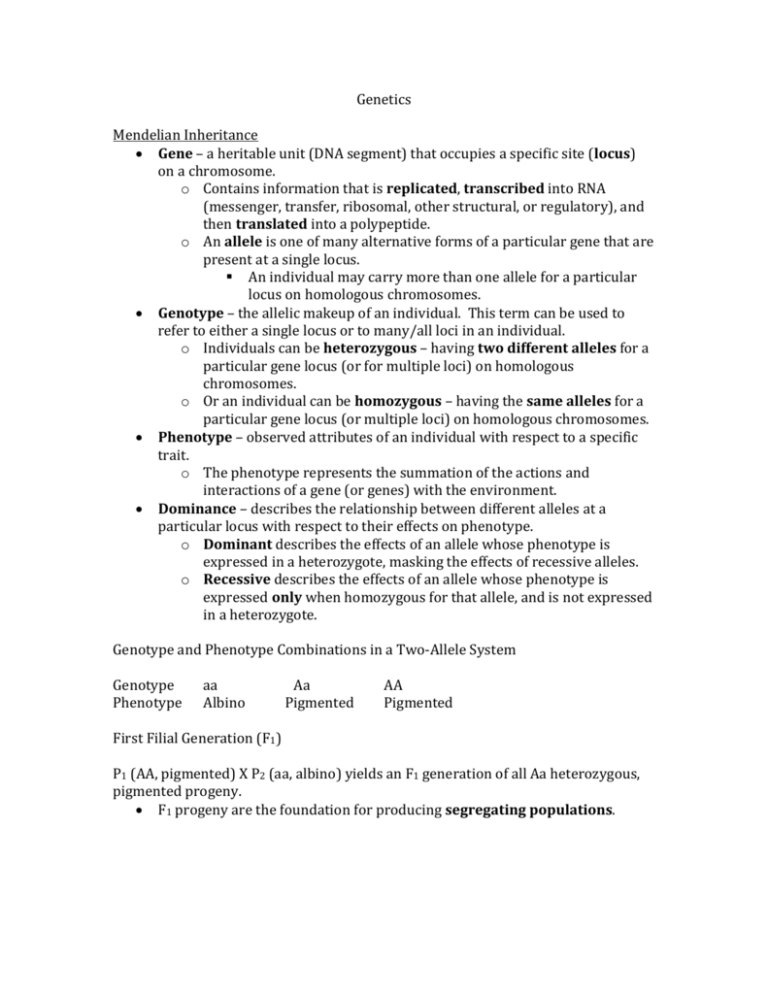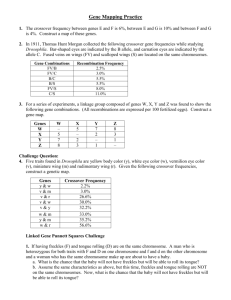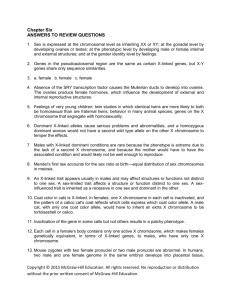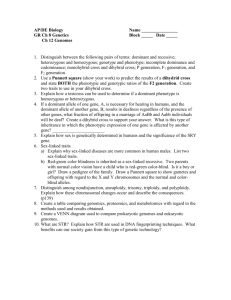Genetics Mendelian Inheritance Gene – a heritable unit (DNA
advertisement

Genetics Mendelian Inheritance Gene – a heritable unit (DNA segment) that occupies a specific site (locus) on a chromosome. o Contains information that is replicated, transcribed into RNA (messenger, transfer, ribosomal, other structural, or regulatory), and then translated into a polypeptide. o An allele is one of many alternative forms of a particular gene that are present at a single locus. An individual may carry more than one allele for a particular locus on homologous chromosomes. Genotype – the allelic makeup of an individual. This term can be used to refer to either a single locus or to many/all loci in an individual. o Individuals can be heterozygous – having two different alleles for a particular gene locus (or for multiple loci) on homologous chromosomes. o Or an individual can be homozygous – having the same alleles for a particular gene locus (or multiple loci) on homologous chromosomes. Phenotype – observed attributes of an individual with respect to a specific trait. o The phenotype represents the summation of the actions and interactions of a gene (or genes) with the environment. Dominance – describes the relationship between different alleles at a particular locus with respect to their effects on phenotype. o Dominant describes the effects of an allele whose phenotype is expressed in a heterozygote, masking the effects of recessive alleles. o Recessive describes the effects of an allele whose phenotype is expressed only when homozygous for that allele, and is not expressed in a heterozygote. Genotype and Phenotype Combinations in a Two-Allele System Genotype Phenotype aa Albino Aa Pigmented AA Pigmented First Filial Generation (F1) P1 (AA, pigmented) X P2 (aa, albino) yields an F1 generation of all Aa heterozygous, pigmented progeny. F1 progeny are the foundation for producing segregating populations. Backcross (Testcross) – can be used to determine the genotype of progeny exhibiting a dominant phenotype (i.e. whether an individual is homozygous or heterozygous dominant). F1 (Aa) X P2 (aa) yields a genotypic ratio of 1Aa : 1aa, and a phenotypic ratio of 1 pigmented : 1 albino. Gametes a A Aa a aa *In this example a testcross is not really necessary, because the genotypes of both parents were known, but this method can be used to determine genotypes in later generations in which the genotype cannot be known with certainty. Intercross – F1 X F1 yields F2 offspring with an anticipated genotypic ratio of 1 : 2 : 1 and an anticipated phenotypic ratio of 3 : 1. Gametes A a A AA Aa a Aa aa Mendel’s First Law (Segregation) – The two members of a gene pair segregate from each other into gametes, such that one half of the gametes carry one member of the pair, and one half of the gametes carry the other member of the gene pair. Two Genes on Different Chromosomes – when genes are present on different chromosomes, they may exert their effects independently of one another. In such cases, one gene is not said to be dominant to another, but they are co-expressed or repressed based on their independent allelic makeup: Ex: Snakes that possess at least one dominant allele for the gene that encodes Enzyme A will have black pigment. Similarly, snakes that possess at least one dominant allele for the gene that encodes Enzyme B will have orange pigment. If Enzyme A and Enzyme B are expressed, one does not dominate the other; both pigments are expressed. Genotypes of an F2 Generation derived from an intercross of F1 Heterozygotes (AaBb) Gametes AB Ab aB ab AB AABB AABb AaBB AaBb Ab AABb AAbb AaBb Aabb aB AaBB AaBb aaBB aaBb ab AaBb Aabb aaBb aabb While the genotypic ratio is quite variable, the phenotypic ratio exhibited is: 9 Black & Orange : 3 Black : 3 Orange : 1 Albino Mendel’s Second Law (Independent Assortment) – During gamete formation, the segregation of one gene pair is independent of the other gene pair. The above example illustrates this, because each heterozygote may potentially produce four different gametes, each with a different genotypic makeup. If there is only one locus per chromosome, with each locus having only two alleles, each pair of chromosome classes has three potential genotypes (for example, AA/Aa/aa). Thus, a gamete has 3n potential combinations, where n is the number of chromosome pairs in an organism. o For humans, n=23, so 323 = 94 billion combinations. Autosomal Dominant Traits Criteria: o Trait usually appears in every generation. o Inherited in a vertical manner (the trait does not skip generations). o Affected individuals rarely have both parents affected, Only rare traits are of interest in studies (i.e. rare diseases). o Each child of an affected individual has a 50% chance of being affected. o Males and females are affected with equal frequency and severity (NO sex bias in progeny). o Both males and females can transmit the trait (NO sex bias in transmission). o Unaffected individuals do NOT transmit trait to their children. o Homozygotes for some autosomal disorders may have a more severe form of the disease(e.g. achondroplasia), while in other disorders there is little difference between individuals carrying one or both abnormal alleles (e.g. Huntington’s disease). o Affected parent (Aa) mating with unaffected parent (aa) will result in a 1Aa : 1 aa genotypic ratio in progeny, and therefore there is a 50% risk of children being affected. Characteristics of Autosomal Dominant traits: o New mutations causing autosomal dominant disorders occur with some regularity. o The more severe the phenotype, the more likely it is due to a new mutation. o Advanced paternal age is sometimes correlated with an increased likelihood of a new mutation. o Many proteins altered in autosomal dominant disorders are structural proteins (e.g. collagens and fibrillin). Haploinsufficiency – refers to cases in which a diploid organism has only a single functional copy of a gene (the other copy is inactivated due to mutation) and the single functional copy does not produce sufficient gene product (usually a protein) to exhibit a normal phenotype – result is an abnormal or disease state. o Responsible for some (but not all) autosomal dominant disorders. o Ex: William’s Syndrome – caused by deletions of a variable number of genes in hemizygotes (individuals with only one member of a chromosome pair, often refers to X-linked genes in males) including the gene that encodes the elastin protein. Causes aortic stenosis. Dyskeratosis Congenita – null mutation of telomerase reverse transcriptase (TERT), leading to abnormal skin manifestations, bone marrow failure, pulmonary fibrosis and increased predisposition to cancer. Dominant-Negative Mutations – refer to mutations in gene products that are expressed and act in a negative (deleterious) manner to other products that are normal (wild-type). Most often used to describe interactions in a multimeric protein, in which a mutant gene product (polypeptide) hinders or prevents the function of the protein as a whole. o Ex: Marfan Syndrome – an autosomal dominant mutation in the FBN1 gene encoding fibrillin-1. Fibrillin is an ECM protein that constitutes the bulk of the microfibrillar component of elastic tissues. Abnormal fibrillin-1 affects connective tissues throughout the body. Variable expression can result from differences in mutant alleles, but is also seen in different members of the same family who would be expected to carry the same allele. Example Pedigree Chart for Autosomal Dominant Traits: Autosomal Recessive Traits Criteria: o Usually affects one generation in a single sibship (brothers and sisters). o Parents or offspring of proband usually not affected (usually heterozygous carriers). o Horizontal pattern of inheritance (skips generations). o Heterozygotes are almost always unaffected. o NO sex bias in progeny. o NO sex bias in transmission. Patterns: o Full-sibs of affected individual (or offspring of known heterozygous parents) have 25% chance of being affected regardless of sex or birth order. o Unaffected siblings of an affected child (aa) have 2/3 chance of being a carrier (Aa) and 1/3 chance of being homozygous for normal allele (AA). o Each offspring of an affected individual (aa) will be a carrier (Aa heterozygote) and therefore will be unaffected, unless the other parent is also a carrier (Aa) or also affected (aa). o Mating between an affected individual (aa) and a homozygous unaffected individual (AA) will result in unaffected progeny who are all carriers (Aa). Characteristics: o The rarer the trait, the more likely the parents of affected progeny are closely related (i.e. consanguineous mating). o Consanguinity increases likelihood of having children affected with recessive disorders due to increased inbreeding. o Abnormal proteins associated with disorders are often enzymes. o Heterozygotes usually do not manifest an abnormal phenotype – ½ of normal enzyme is usually sufficient to complete biochemical reactions (not true of X-linked traits in males). o Most biochemical disorders are autosomal recessive. Ex: Tay-Sachs Disease –lysosomal storage disease caused by mutations in the hexosaminidase A gene (HEXA). o Hexosaminidase A is a dimeric enzyme (one α, one �) chain. o Mutation in the HEXA gene leads to production of defective α-chains that are unable to degrade GM2 gangliosides, leading to its accumulation in nervous tissue and neurodegeneration. o Symptoms: Cerebral degeneration, blindness, loss of motor function. Results in death, usually 2-4 years of age. o Frequency of disease highest among the Ashkenazi Jews. Example Pedigree Chart for Autosomal Recessive Traits: **Double bar represents consanguineous mating pair. Sex Chromosomes – humans have 22 pairs of autosomal chromosomes and one pair of sex hormones. (Male XY, Female XX). The X chromosome carries much more genetic information than the Y chromosome. Males are hemizygous for most genes on the X chromosome (i.e. carrying only one copy). o **For these genes, whichever allele is inherited will be expressed. Dosage Compensation: o X-inactivation – all but one X chromosome is inactivated, therefore most of the genes on an inactivated X chromosome are not transcribed. This functions to balance the amount of genetic information expressed in males and females. o Inactivated chromosomes are observed as Barr bodies. Lyon Hypothesis: o X-inactivation in mammals occurs early in embryonic life, is random, complete and permanent. o X-inactivation is random for most women. Anhidrotic ectodermal dysplasia o Involves a gene on the X chromosome, therefore there is a higher chance that males will be affected. o Mutant allele causes a lack of sweat glands. o Mutant sectors of skin can be detected by altered electrical resistance. X-Linked Recessive Traits Criteria: o Sex bias in affected progeny (much higher in males). Males are also almost always much more severely affected compared to females. o The mutant allele (and thus disorder) is almost never transmitted from father to son (no male-to-male transmission). Thus, there is a sex bias in transmission. o Daughters of affected (hemizygous) fathers inherit the affected gene, and are all carriers. o Sons of affected fathers are unaffected. o Daughters of a carrier mother are all unaffected, but 50% will be carriers. o Sons of a carrier mother have a 50% chance of being affected. Unaffected Father Gametes XG Y G G G Carrier Mother X X X XGY Xg XG Xg XgY Characteristics: o Many females heterozygous for X-linked disorders may show a minor manifestation of the disorder (manifesting carriers). o Skewed X-inactivation may cause some carrier females to have more severe manifestations. o Newly arising mutations can also cause X-linked disorders (may occur more frequently in sperm, leading to new carrier females). o About 1/3 of all cases of genetically-lethal X-linked disorders are due to newly-arising mutations. Example of X-linked recessive trait = Hemophilia A (bleeding disorder caused by mutations in the Factor VIII gene). Example Pedigree Chart For X-Linked Recessive Trait: X-Linked Dominant Traits Criteria: o Pattern of inheritance is similar to that of X-linked recessive traits, but the abnormal gene is expressed in both males and females. o Males are generally more severely affected. o There are twice as many affected females compared to males (sex bias in affected progeny). o There is NO father-to-son transmission (sex bias in transmission). o For affected males (XRY), sons are unaffected and daughters are all affected (XRX). o For affected Females (XRX), there are equal numbers of sons and daughters affected, and they have a 50% chance of being affected: Normal Male Affected X Y Female XR XR X XRY X XX XY Characteristics: o These traits are very rare, and some are lethal in utero in males. Because of this, sometimes only females appear affected, because no males reach term. Affected females would have fewer sons than daughters (and also an increased frequency of miscarriages). X-Linked Dominant Hypophosphatemia o Associated with Vitamin D-resistant rickets: Low blood phosphate levels. High urinary phosphate levels. Short stature. Bone Defects. o Defects in PHEX (phosphate-regulating gene with homologies to endopeptidases on the X chromosome) locus on the short arm of X chromosome. Example Pedigree of X-Linked Dominant Trait: Y-Linked (Hollandric) Inheritance Criteria: o Only males affected (sex bias in affected progeny). o Only father-to-son transmission (sex bias in transmission). o Ex: male gender. Characteristics: o Very few genes known to be on the Y chromosome. o Y chromosome composed of two regions: Pseudoautosomal (PAR) regions (~5% of Y chromosome): Small regions at the termini of long and short arms of X and Y-chromosomes are homologous. Can undergo recombination during meiosis. Contain a large portion of Y chromosome genes. Male-specific region (~95% of Y chromosome): Mostly heterochromatin, few genes. Most of these genes are associated with testicular function (e.g. SRY sex-determining region). Example Pedigree of Y-Linked Inheritance Co-Dominant Traits –gene products of BOTH alleles are expressed in the heterozygote. Example: ABO / MN blood type loci. IAi (A blood type) IBi (B blood type) IA i B A B B I I I (AB) I i (B) A i I i (A) ii (O) Inheritance Pattern Grid









